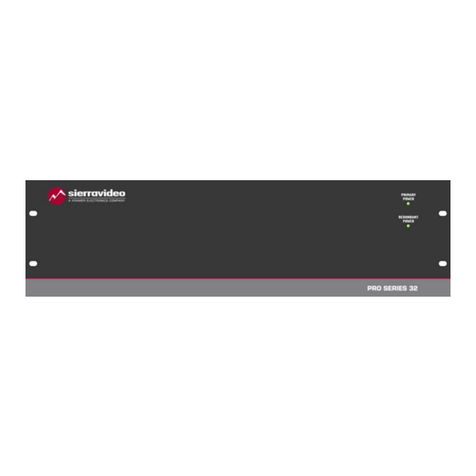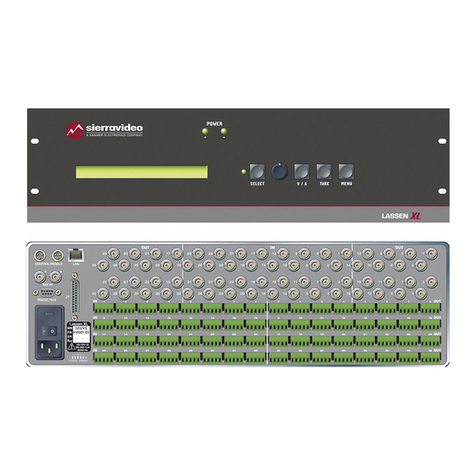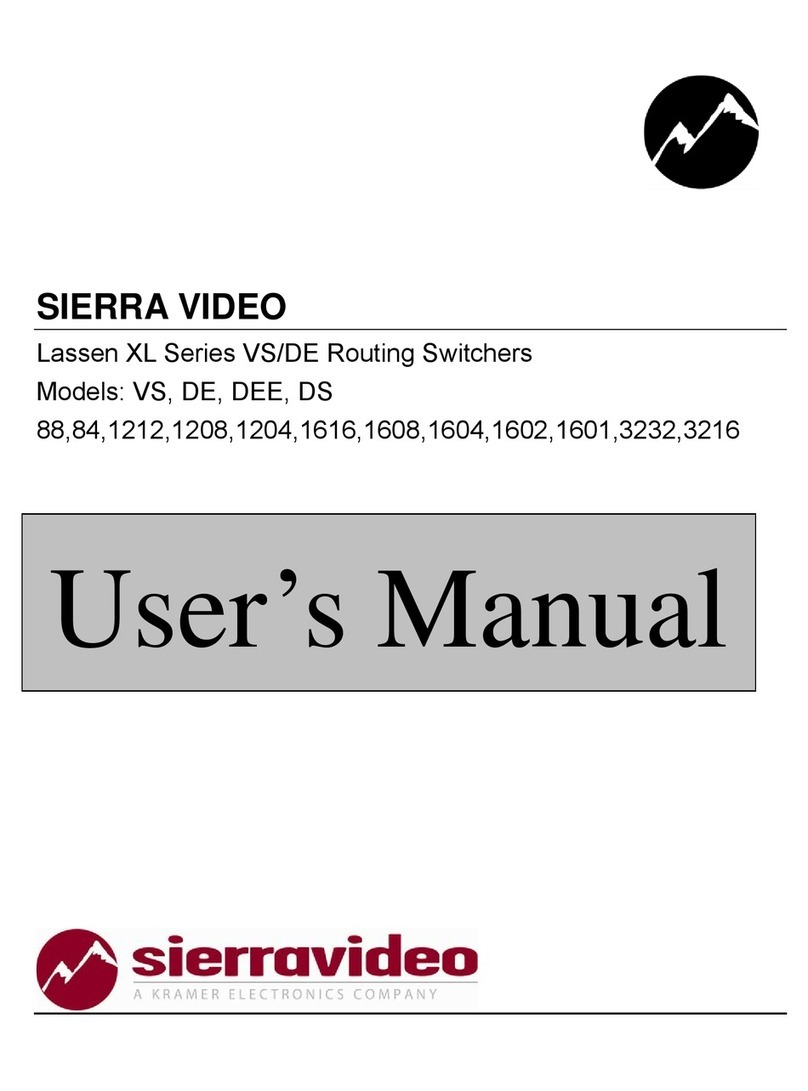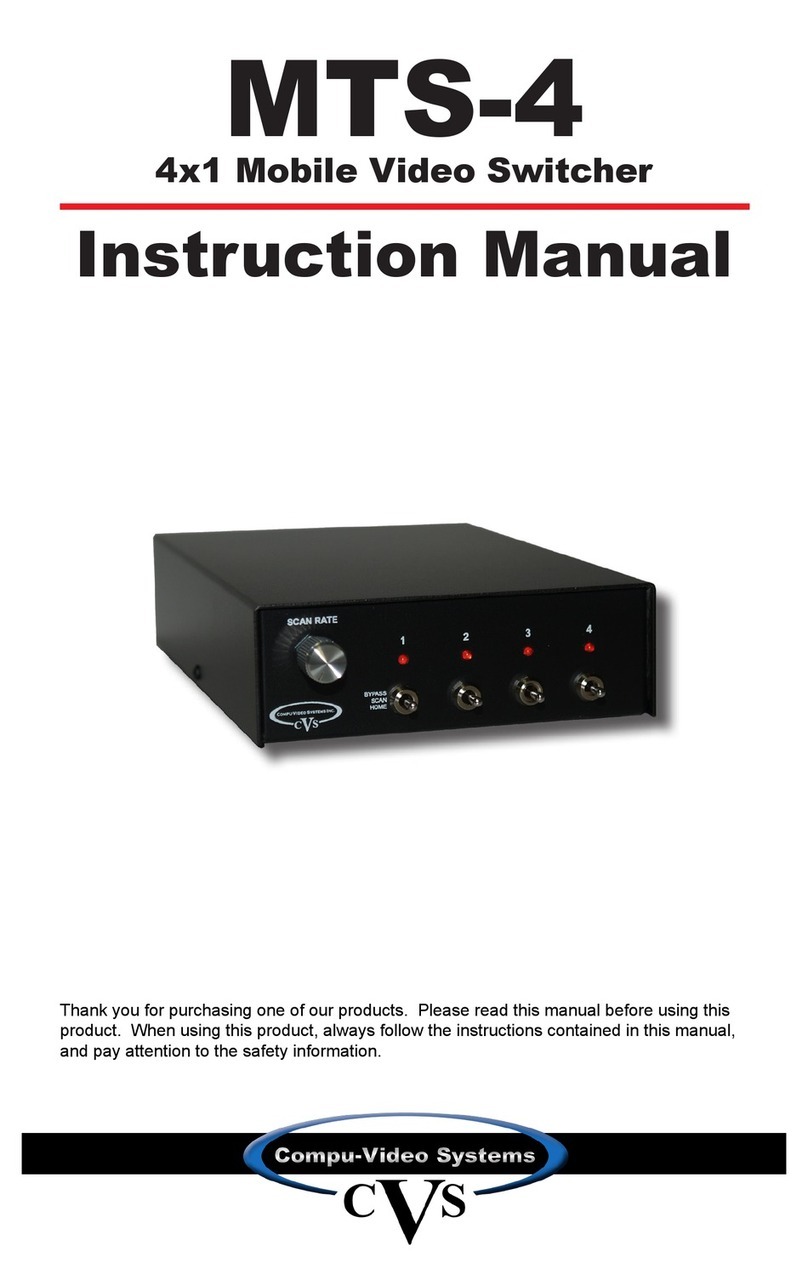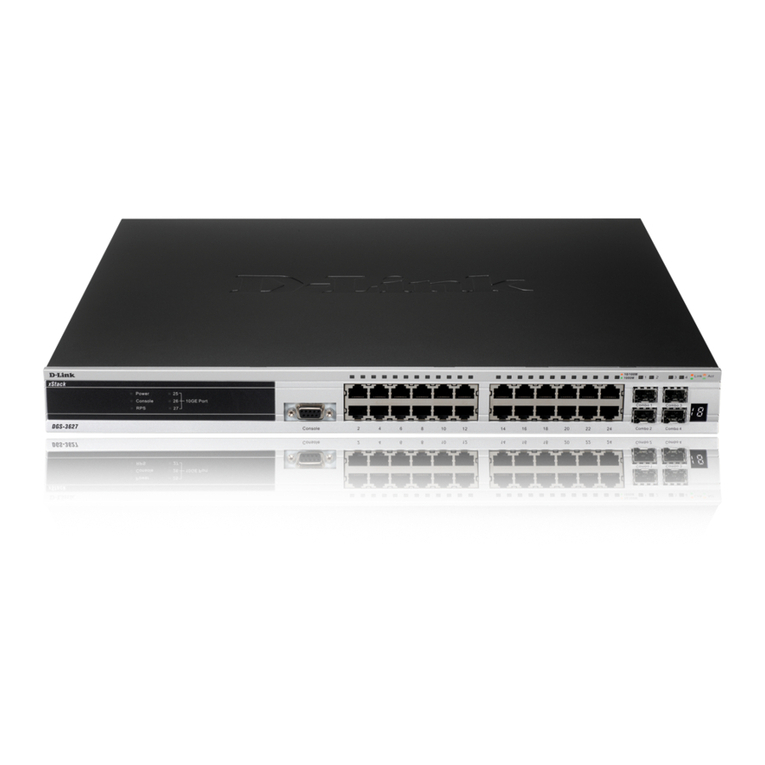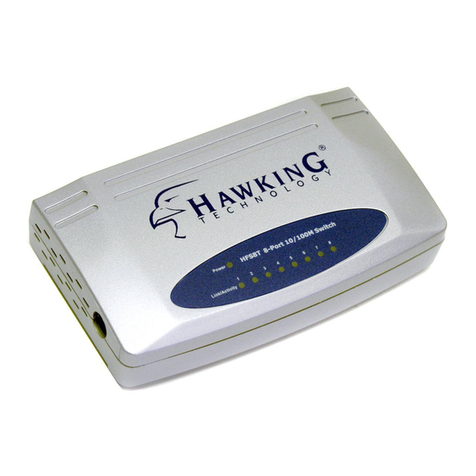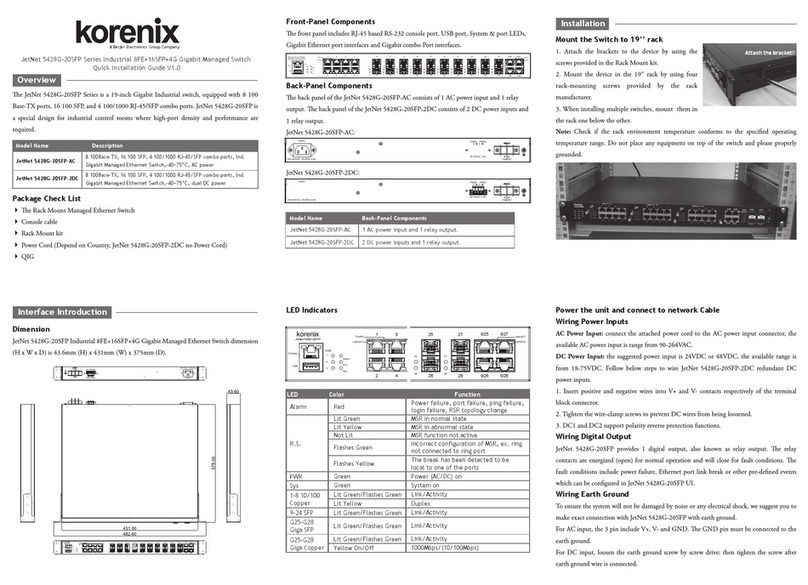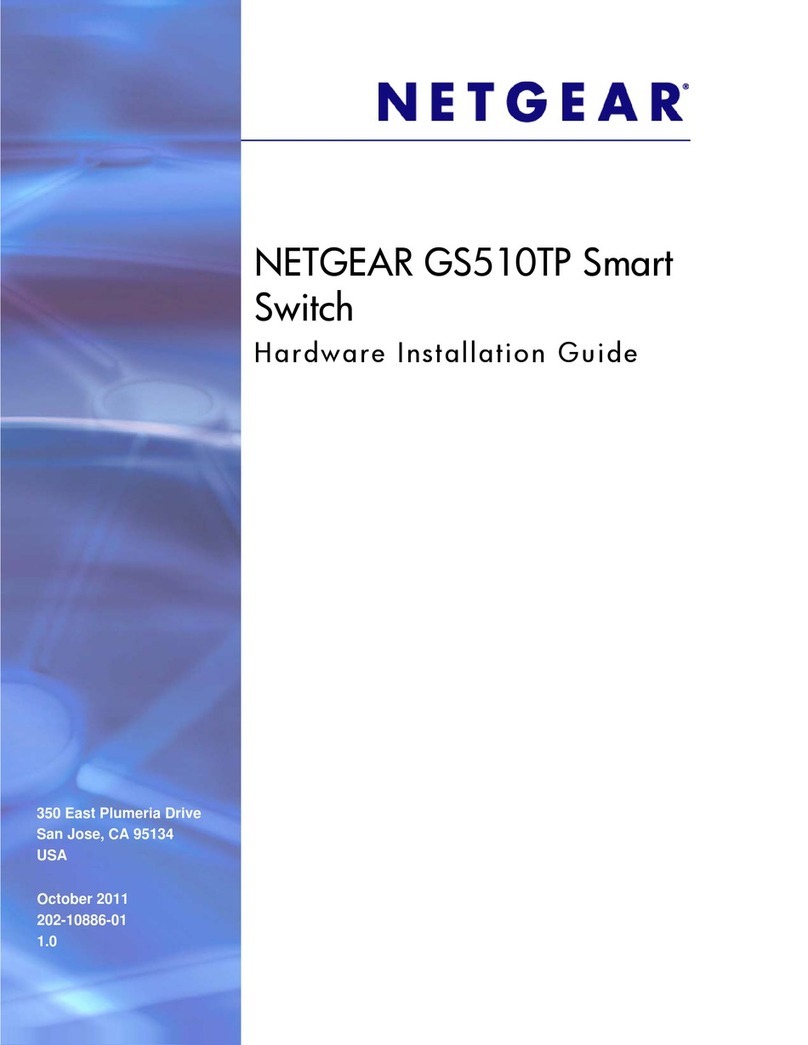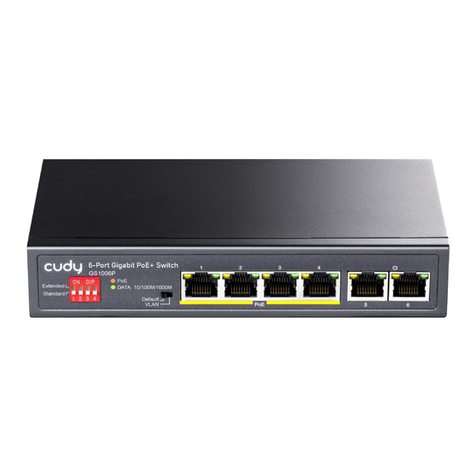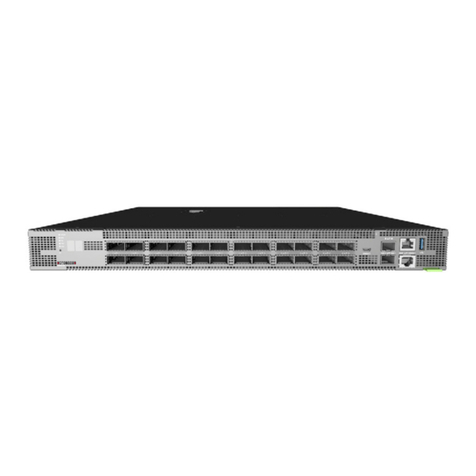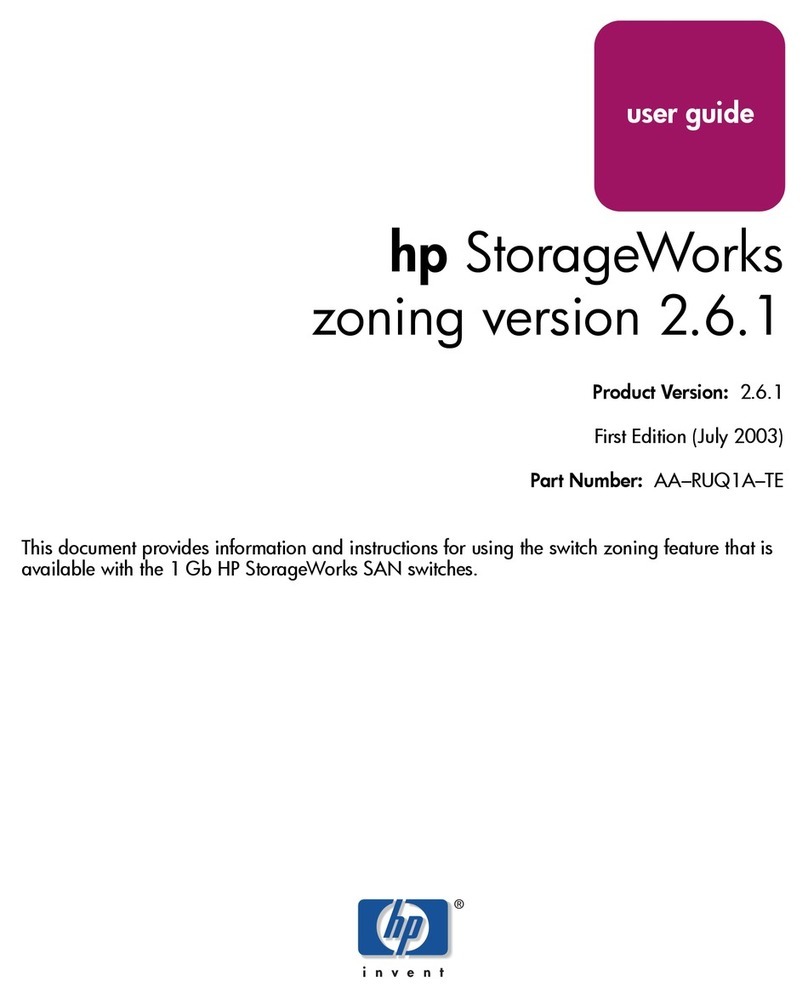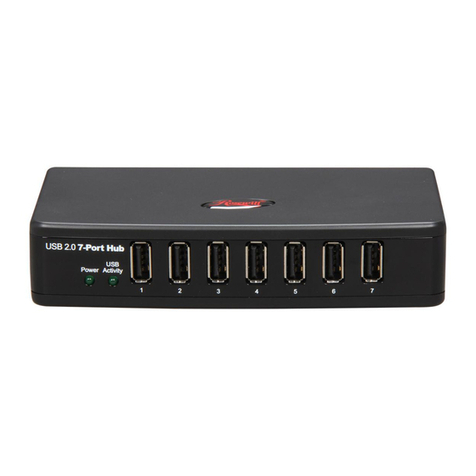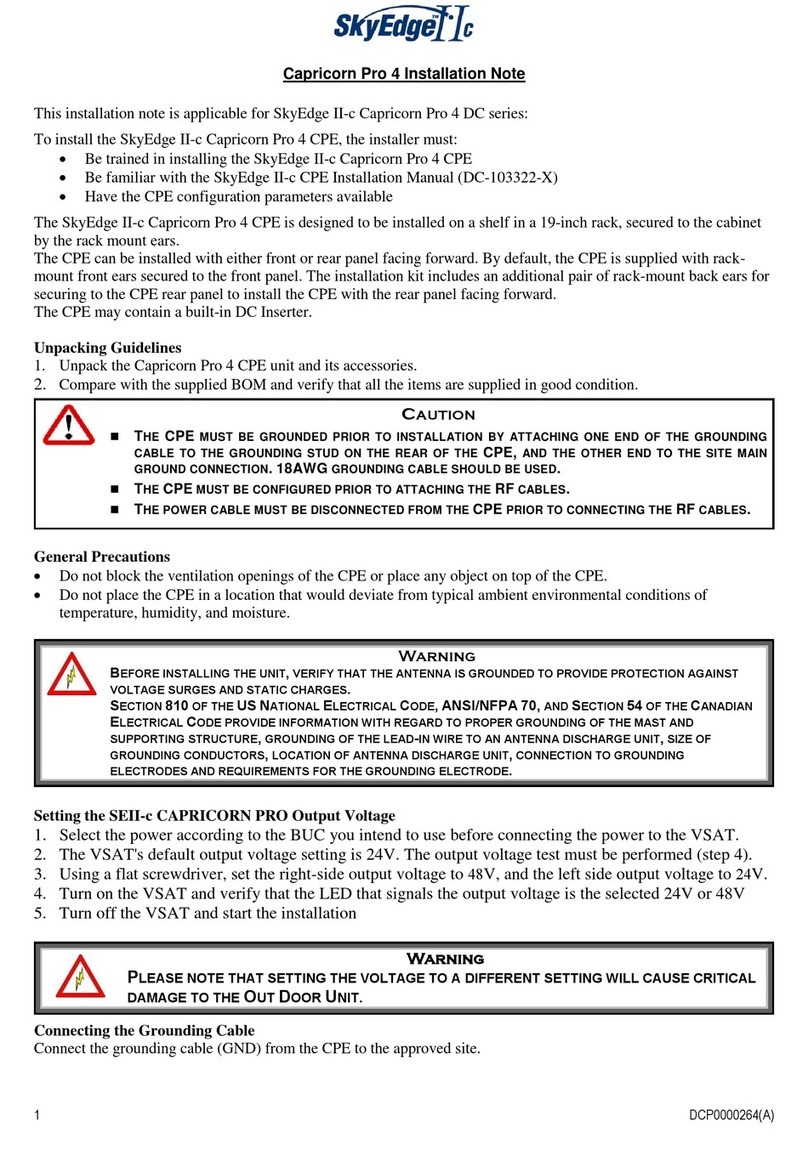Sierra Video Viper Component Series User manual

SIERRA VIDEO
Viper™ Component Series Routing Switcher
User’s Manual


VIPER™ SERIES ROUTING SWITCHER
User’s Manual
Sierra Video
P.O. Box 2462 Grass Valley, CA 95945
Tel: (530) 478-1000
Fax: (530) 478-1105
Version 4.0
Publication Date: February 2012
The information contained in this manual is subject to change by Sierra Video


Contents - 1
Table of
Contents
Introduction 1
Before You Begin 1
Regulatory Warnings & Safety Information 2
FCC Notice 3
Warning 3
Power Supply Cords 4
North American Power Supply Cords 4
International Power Supply Cords 4
EMC Regulatory Notices 4
Delivery Damage Inspection 4
Viper™ Wideband Routing Switcher 5
Introduction 5
Viper RGBHV Frame 6
Factors Affecting Quality of Results 8
Installation 9
Introduction 9
Rack Mounting 9
Multi-Frame Connections 10
Connecting To Video Devices 11
Sync 11
Connecting Peripherals 13
Master Frame Rear Panel 13
Slave Frame Rear Panel 14
Reference Sync 15
AC Power Connections 16
Control Processor DIP Switches 17
DIP Switch Settings Cont. 18
Ethernet Setup 19
GPI 28
Suggested GPI Circuitry 29
Software Upgrades 30
Audio 31
Introduction 31
Control System Overview 31
Model 128128A 32
Model 6464A 33
Stereo Configurations 35
Connecting to Audio Devices 36
Mono Analog Audio 36
Balanced/Unbalanced Analog Audio
Connections 36
Stereo Analog Audio 36
Analog Audio Signal Path Overview 37
Input Buffers 37
Crosspoint/ Output Driver Modules 39
Module Layout 40
6464 Frame Analog Mono 40
6464 Frame Analog Stereo 40
128128 Frame Analog Mono 41
128128 Frame Analog Stereo 41
Front Door Fans 41
Operation 43
Introduction 43
Control System Overview 43
Serial Control Ports 44
Host Mode 44
Terminal Mode 44
Control Panels 45
Video Module Overview 47
Introduction 47
Module Layout 48
Input Module 49
Crosspoint Module 51
Output Module 52
Processor Module 53
Sync Modules 54
Power Supply Module 55
Specifications 57
Communication Protocol 61
Introduction 61
Generic Protocol 62
Commonly Used Switching Commands 82
Warranty 83


SIERRA VIDEO
1
Introduction
Before You Begin
There are several terms and acronyms that you should become familiar with before reading this
manual. They are shown below.
Term/Acronym Definition
Crosspoint The electronic switch that assigns one of the inputs on the
matrix crosspoint modules to an output.
Destination A device that receives signals from the output of the
switcher.
Output The signal that connects to the destination device.
Source The signal that is connected to the input of the routing
switcher.
Input Connected to the source that provides the signal to the
switcher.
Matrix An array of the switch modules that connects an input to an
output.
Protocol The command structure used to affect a switch or multiple
switches on the routing switcher or to control other
functions.
Routing Switcher Consists of one or more crosspoint modules that switch
together, or sometimes independently, to connect the
desired signals through the switcher.
Serial Port The 9-pin RS232 connector that allows you to control the
switcher using a standard personal computer or other
external device. Sends control protocol commands in
ASCII.
Chapter
1

SIERRA VIDEO
2
Regulatory Warnings & Safety Information
The information in the following section provides important warnings and safety guidelines for
both the operator and service personnel. Specific warnings and cautions may be found
throughout this manual. Please read and follow the important safety precautions noting especially
those instructions relating to risk of fire, electrical shock and injury to persons.
Any instructions in this manual that require opening the equipment cover or enclosure are
intended for use by qualified service personnel only. To reduce the risk of electrical shock, do not
perform any servicing other than what is contained in the operating instructions unless you are
qualified.
Warnings
Heed all warnings on the unit and in the operating instructions.
Disconnect AC power before installing or removing device or servicing unit.
Do not use this product in or near water.
This product is grounded through the grounding conductor of the power cord. To
avoid electrical shock, plug the power cord into a properly wired receptacle before
connecting inputs or outputs.
Route power cords and other cables so that they are not likely to be damaged, or
create a hazard.
Dangerous voltages exist at several points in this product. To avoid personal injury,
do not touch unsafe connections and components when the power is on.
To avoid fire hazard, use only the specified type, correct voltage, and current rating
of fuse. Always refer fuse replacement to qualified service personnel.
Have qualified personnel perform safety checks after any completed service.
To reduce risk of electrical shock, be certain to plug each power supply cord into a
separate branch circuit employing a separate service ground.
If equipped with redundant power, this unit has two power cords. To reduce the risk
of electrical shock, disconnect both power cords before servicing.
Operate only with covers and enclosure panels in place – Do Not operate this
product when covers or enclosure panels are removed.
This is an FCC class A product. In a domestic environment, this product may cause
radio interference, in which case the user may be required to take necessary
measures.
Cautions
Use the proper AC voltage to supply power to the switcher. When installing
equipment, do not attach the power cord to building surfaces.
To prevent damage to equipment when replacing fuses, locate and correct the trouble
that caused the fuse to blow before applying power.
Use only the recommended interconnect cables to connect the switcher to other
frames.
Follow static precautions at all times when handling the equipment.
Power this product only as described in the installation section of this manual.

VIPER COMPONENT SERIES
3
Cautions (continued)
Leave the sides, top, and bottom of the frame clear for air convection cooling and to
allow room for cabling. Slot and openings in the frame are provided for ventilation
and should not be blocked.
Only an authorized Sierra Video technician should service the switchers. Any user
who makes changes or modifications to the unit without the expressed approval of
Sierra Video will void the warranty.
If installed in a closed or multi-unit rack assembly, the operating ambient
temperature of the rack environment may be greater than the room ambient
temperature. Therefore, consideration should be given to installing the equipment in
an environment compatible with the manufacturer’s maximum rated ambient
temperature (TMRA).
Installation of the equipment in a rack should be such that the amount of air flow
required for safe operation of the equipment is not compromised.
Use a shielded data cable connection between the parallel data ports and peripherals
of this equipment.
Other connections between peripherals of this equipment may be made with low
voltage non-shielded computer data cables.
Network connections may consist of non-shielded CAT 5 cable.
Do not cover chassis ventilation slots or block enclosure openings.
FCC Notice
This equipment has been tested and found to comply with the limits for a Class A digital device, pursuant
to Part 15 of the FCC rules. These limits are designed to provide reasonable protection against harmful
interference when the equipment is operated in a commercial environment. This equipment generates,
uses, and can radiate radio frequency energy and, if not installed and used in accordance with the
instruction manual, may cause harmful interference to radio communications. Operation of this equipment
in a residential area is likely to cause harmful interference in which case the user will be required to
correct the interference at the expense of the user.
The user may find the following publication prepared by the Federal Communications Commission
helpful:
“How to Identify and Resolve Radio-TV Interference Problems” (Stock number 004-000-
00345-4).
Available exclusively from the Superintendent of Documents, Government
Printing Office, Washington, DC 20402 (telephone 202 512-1800).
Warning
Changes or modifications not expressly approved by the party responsible for compliance to Part 15 of
the FCC Rules could void the user’s authority to operate the equipment.

SIERRA VIDEO
4
Power Supply Cords
Use only power cord(s) supplied with the unit.
If power cord(s) were not supplied with the unit, select as follows:
For units installed in the USA and Canada: select a flexible, three-conductor power cord
that is UL listed and CSA certified, with individual conductor wire size of #18 AWG, and a
maximum length of 4.5 meters. The power cord terminations should be NEMA Type 5-
15P (three-prong earthing) at one end and IEC appliance inlet coupler at the other end.
Any of the following types of power cords are acceptable; SV, SVE, SVO, SVT, SVTO,
SVTOO, S, SE, SO, SOO, ST, STO, STOO, SJ, SJE, SJO, SJOO, SJT, SJTOO, SP-3,
G, W.
For units installed in all other countries; select only a flexible, three-conductor power
cord, approved by the cognizant safety organization of your country. The power cord
must be Type HAR (Harmonized), with individual conductor wire size of 0.75 mm². The
power cord terminations should be a suitably rated earthing-type plug at one end and IEC
appliance inlet coupler at the other end. Both of the power cord terminations must carry
the certification label (mark) of the cognizant safety organization of your country.
A non-shielded power cord may be used to connect AC power to every component and
peripheral of the system.
Connect an external 18 AWG wire from earth ground to the chassis of the system as
designated by the earth ground symbol.
North American Power Supply Cords
This equipment is supplied with North American power cords with molded grounded plug (NEMA-
15P) at one end and molded grounding connector (IEC 320-C13) at the other end. Conductors
are CEE color coded, light blue(neutral), brown(line), and green/yellow(ground). Operation of the
equipment at voltages exceeding 130VAC will require power supply cords that comply with NEMA
configurations.
International Power Supply Cords
If shipped outside North America, this equipment is supplied with molded ground connector (IEC
320-C13) at one end and stripped connectors (50/5mm) at the other end. Connections are CEE
color coded, light blue (neutral), brown(line), and green/yellow(ground). Other IEC 320-C13 type
power cords can be used if they comply with safety regulations of the country in which they are
installed.
EMC Regulatory Notices
Federal Communications Commission (FCC) Part 15 Information: This device complies with Part
15 of the FCC standard rules. Operation is subject to the following conditions:
This device may not cause harmful interference
This device must accept any interference received including interference that may cause
undesirable operations.
Delivery Damage Inspection
Carefully inspect the frame and exterior components to be sure that there has been no shipping
damage. Make sure all modules are seated correctly and have not detached during shipment.

VIPER COMPONENT SERIES
5
Viper™ Wideband Routing Switcher
Introduction
500MHz RGBHV Routing Switcher up to 64x64
The new wideband video routing switcher from Sierra Video is top-of-the-line modular routing for
those applications requiring worry-free performance and mission critical reliability. The advanced
features and performance set it apart from the competition. These include:
Modular configurations expandable by 8 input and/or 8 output increments
Compact frame size – 10RU smaller than most competitive units (in RGBHV)
Hot-swappable video I/O boards, CPU boards, and power supplies
Optional redundant power supplies and control processors
Full range of Sierra control hardware and software components, including remote control
panels, IP and serial control. Supported by all major third party control systems.
Front-door access to hot-swappable video I/O boards allows for field service or matrix
reconfiguration. The power supplies are also hot-swappable, guarantee maximum in-service time
and minimal interruptions. IP (Ethernet) control via TCP/IP socket connection is standard in
every model.
For applications requiring companion audio, the wideband routing switcher is compatible with our
time-tested Yosemite line of audio routing switchers. Sierra Video advanced SCP line of
programmable control panels manage the routing system along with our new TyLinx™ router
control software featuring the most intuitive router interface in the industry.
This manual covers only the Viper routing switcher. These robust routers offer RGB/HV compact
frames. Moreover, these durable frames can be populated from one to five video and pulse sync
channels. They have been engineered for high bandwidth with very low crosstalk. Many other
features include control via serial ports and optional processor and/or power redundancy. The
Viper™series can be configured to support composite, s-video, YC, YUV, RGBHV, analog HD.

SIERRA VIDEO
6
Viper RGBHV Frame
Frame Front Panels

VIPER COMPONENT SERIES
7
Frame Rear Panels
Note
The Viper models shown here and in the
subsequent sections are fully populated video
matrices. In some cases, the system may be
configured with fewer video channels and/or
frames. i.e. Viper models also offer redundant
power supplies. Consult the rear panel serial
number and model number to verify your order
and product.
The system you receive is customized for the size
& type requested at time of purchase from Sierra
Video.
RED
GREEN
BLUE
H/HV SYNC
V SYNC

SIERRA VIDEO
8
Factors Affecting Quality of Results
There are many factors affecting the quality of results when signals are transmitted from a source to a
destination.
Signal cables — Use only the best quality cables to avoid interference, degraded
signal quality and elevated noise levels.
Sockets and connectors of the sources and destinations — Use only the highest
quality, since "zero ohm" connection resistance is the target. Connectors should
also match the required impedance (75 ohm in video) to minimize return loss.
Amplifying circuitry — Must have quality performance when the desired end
result is high linearity, low distortion, and low noise.
Distance between sources and destinations — Plays a major role in the final
result. For long distances (over 15 meters) between sources and destinations,
special measures should be taken to avoid high frequency cable losses. These
measures include using higher quality cables and/or adding line cable equalizing
amplifiers.
Interference from neighboring electrical appliances — These can have an
adverse affect on signal quality. Balanced audio lines are less prone to
interference, but unbalanced audio should be installed away from any main
power lines, electric motors, transmitters, etc. even when the cables are shielded.
CAUTION!
Only an authorized Sierra Video technician can service the switchers. Any user who makes
changes or modifications to the unit without the expressed approval of the manufacturer will void
the warranty.
Use the proper AC voltage to supply power to the switcher.
Use only the recommended interconnect cables to connect the switcher to other frames

SIERRA VIDEO
9
Installation
Introduction
Installation procedures are similar for all frames covered within this manual. Exceptions, if any,
have been noted in each of the following paragraphs.
Rack Mounting
Carefully inspect the frame to ensure that there has been no shipping damage. Make sure all
shipping material is removed from the router frame.
Each of the routing switchers described in this manual can be rack mounted in a standard 19"
(1RU) EIA rack assembly and includes rack "ears" at the ends of the front of the frames. None of
the switcher models require spacing above or below the unit for ventilation. To rack mount any of
the routing switchers, simply place the unit's rack ears against the rack rails of the rack, and
insert proper rack screws through each of the holes in the rack ears. Always rack mount the
routing switcher prior to plugging the unit into a power receptacle or attaching any cables.
Important; Rear mounting brackets must be installed prior to installation of the router into a
rack. The rear mounting brackets are contained in the accessory kit supplied with your router.
CAUTION!
The operating temperature range of the Viper series router is 0 to 40 °C. Do not exceed the maximum (40
°C) or minimum (0 °C) operating temperature.
Rear mounting brackets must be installed prior to installation of the router into a rack. The rear mounting
brackets are contained in the accessory kit supplied with your router.
If installed in a closed or multi-unit rack assembly, the operating ambient temperature of the rack
environment may be greater than the room ambient temperature. Therefore, consideration should be
given to installing the equipment in an environment compatible with the manufacturer’s maximum rated
ambient temperature (TMRA).
Installation of the equipment in a rack should be such that the amount of air flow required for safe
operation of the equipment is not compromised.
Chapter
2

SIERRA VIDEO
10
Multi-Frame Connections
The Viper RGBHV system consists of 5 individual frames connected together so that all 5 frames
operate as a single routing system. The “RED” frame contains the “Master” processor whereas
the other 4 frames each contain a “Slave” processor. The action of the slave frames are
controlled exclusively by the frame with the master processor. The frames are connected via a
“looping” 9-pin cable connected to the “multi-drop 1” port on each frame. The 25 pin J1 connector
is used when the audio option is ordered.
Control panels and serial control connect to the frame containing the master processor.
Master Frame
“RED”
Level 1
Multi Drop 1
Slave Frame
“BLUE”
Level 3
Slave Frame
“H/HV SYNC”
Level 4
Slave Frame
“V SYNC”
Level 5
Slave Frame
“GREEN”
Level 2
Multi Drop 1
Multi Drop 2
Multi Drop 1
Multi Drop 2
Multi Drop 1
Multi Drop 2
Multi Drop 1
Control Panels, RS-232/422 Serial
Control and Ethernet control Connect to
This Frame
9 Pin Multi-Frame
Interconnect Cables
See the “Connecting Peripherals”
section of this manual for details.
J1
Optional Audio
Frame(s)
J1

VIPER COMPONENT SERIES
11
Connecting To Video Devices
Video sources and output devices (such as monitors, or recorders) may be connected to the
routing switchers through the BNC type connectors located on the back of the unit. Keep in mind
that the output signal format will be that of the input signal format.
All signal connections that use more than one cable interconnecting between devices should be
of equal timing length (example: cables between a camera and the switcher should have the
same time delay).
The rear panel of the frame is laid out in the most logical fashion possible. The individual frames
are RED, GREEN, BLUE, H/HV SYNC, and V SYNC. The H/HV and V conventions, used for the
H and V sync channels, are arbitrary and these two channels are interchangeable. Each channel
can have only “H” or “V” signals – not both. All inputs are factory set for 75 ohm termination.
Unused outputs do not need to be terminated.
Sync
Horizontal (“H”) and Vertical (“V”) sync input termination is factory set to 75 ohms. Sync input
terminations can be changed to 510 ohms.
To change sync input terminations;
1. Connect the COMM port from a computer to “CTRL 1” on the back of the “Master” frame.
2. Open HyperTerminal, Hyper Access or other similar terminal emulation program.
3. Set the program’s parameters to 115.2K baud, 8 Data bits, No parity, 1 stop bit, ANSI emulation.
4. Establish communication to the router’s processor by typing **!! on the keyboard. The terminal
program screen will answer **OK!! confirming communication.
Note:
To change sync input termination the “CTRL 1” port must be in the “Host” protocol mode. “CTRL 1” is
factory default to the “Host” mode. However, the CTRL 1 port can be changed to “terminal” via software or
DIP switch. To change the CTRL 1 port to “Host” mode type **HOST1!! (see the operation chapter section
of this manual).

SIERRA VIDEO
12
To set sync input terminations, type in the command(s) below for the type of change you want to
make;
Global change (all sync boards, all sync levels, all sync inputs) to input termination of 75 ohm;
**G XFER_ASCII,253,0,0,0F10FF52~!!
**G XFER_ASCII,253,0,0,0F10FF730401FF~!!
Global change to sync input termination of 510 ohm;
**G XFER_ASCII,253,0,0,0F10FF52~!!
**G XFER_ASCII,253,0,0,0F10FF73040100~!!
Per Board- Per Level All inputs, termination of 75 ohm;
**G XFER_ASCII,253,0,0,0F10FF52~!!
**G XFER_ASCII,253,0,0,(Level)10(Board Address)730401FF~!!
Per Board- Per Level, sync input termination to 510 ohm;
**G XFER_ASCII,253,0,0,0F10FF52~!!
**G XFER_ASCII,253,0,0,(Level)10(Board Address)73040100~!!
Note:
Board inputs are in groups of eight.
Level Numbers;
Level 1= 0
Level 2= 1
Level 3= 2
Level 4= 3
Level 5= 4

VIPER COMPONENT SERIES
13
Connecting Peripherals
Control panels, sync inputs, and power are all connected to the rear of the “Master” frame. The
peripherals area may vary depending on the model size and type.
Master Frame Rear Panel
V
ideo Sync
Referencing
Inputs
(Looping)
RS-232 and RS-422
control connectors
Control Panel
Connectors
Ethernet
Connectors
GPI/0
Multi-Frame Inter
Connect
J1 Connecto
r
Not Used
Not Used

SIERRA VIDEO
14
Slave Frame Rear Panel
Reference sync need not be connected unless the “Slave” frame contains a different signal type
than the “Master” frame, i.e. the master frame has video (which requires video sync) and the
slave frame has AES audio (which requires AES sync).
Multi-Frame
Inter- Connect
Not Used
V
ideo Sync
Referencing
Inputs
Looping
Not Used
This manual suits for next models
1
Table of contents
Other Sierra Video Switch manuals
Popular Switch manuals by other brands
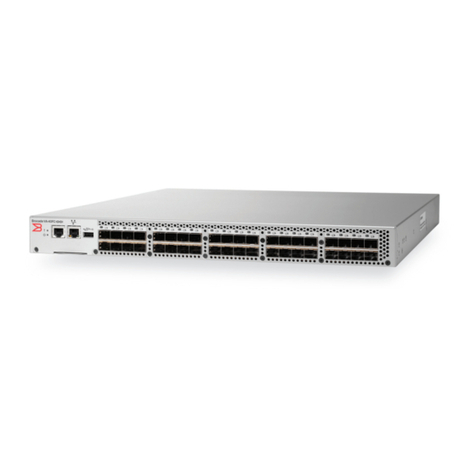
Brocade Communications Systems
Brocade Communications Systems VA-40FC Hardware reference manual
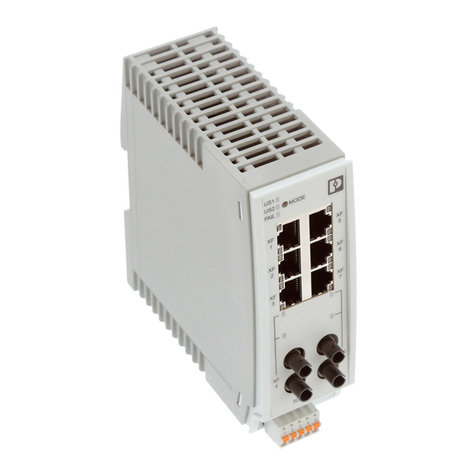
Phoenix Contact
Phoenix Contact FL SWITCH 2206-2FX ST Installation notes for electricians
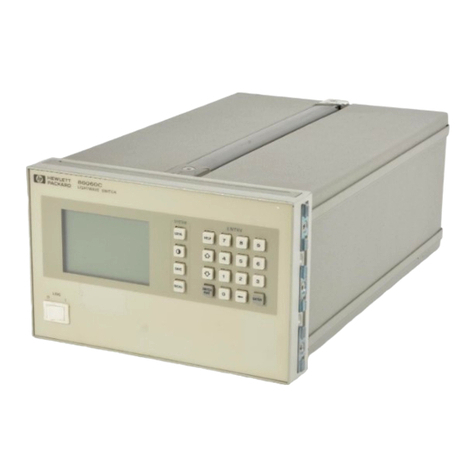
HP
HP 86060C Series user guide
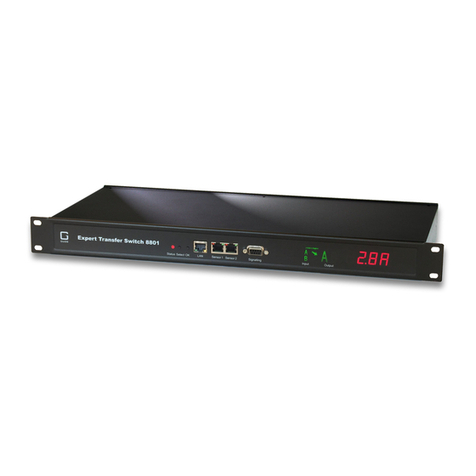
Gude
Gude 8801 manual
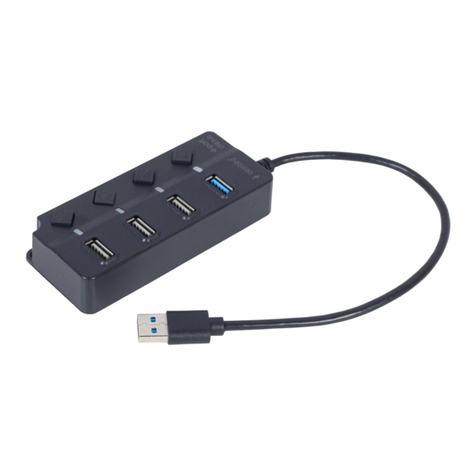
Gembird
Gembird UHB-U3P1U2P3P-01 user manual
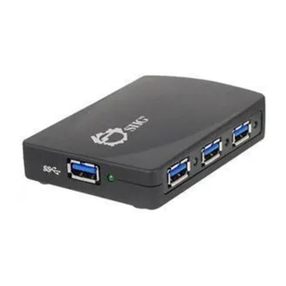
SIIG
SIIG SuperSpeed USB 4-Port Hub Quick installation guide
